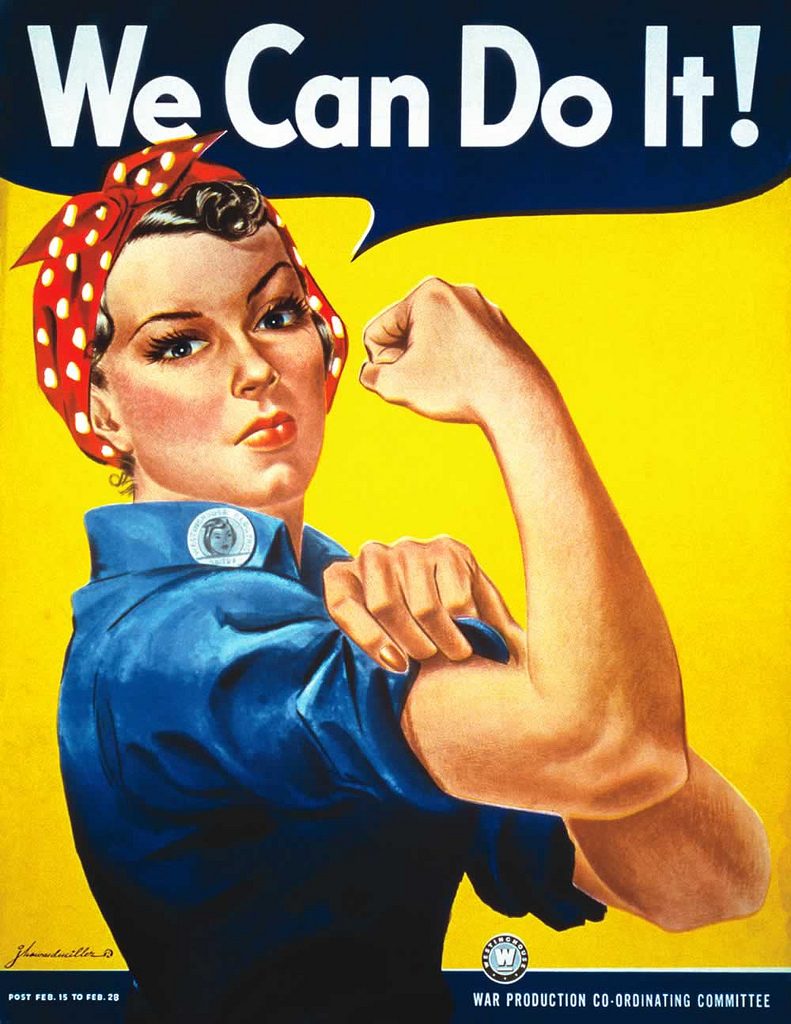From 1941 to 1945, during World War II, many woman were needed in the workplace because millions of men had joined the armed forces to fight in the European and the Pacific theaters of the war. In the Depression years just before this, women had been encouraged to stay at home, and let the men take the reduced number of manufacturing jobs available.1 With the onset of the war and the dramatically increased demand for manufactured wartime products, factories across the country opened their doors to women workers by the millions. In fact, there was a concerted effort to enlist women into the work force. In 1942, artist J. Howard Miller created the popular image of a woman named “Rosie the Riveter.” This poster was initially named, “We Can Do It!” and was made for the Westinghouse Electric and Manufacturing Company. Rosie was represented wearing makeup, a polka dot headband, and a rolled up sleeve shirt that portrayed strength and independence in women.2

Rosie the Riveter was a fictional character that many woman in the workforce identified with. The initial purpose of her image was to influence women to see themselves as capable of doing work previously thought to be men’s work. Her image combined beauty and strength, which is why many woman saw her as a role model. Even though Rosie the Riveter was a fictional character, her image was actually based on a photograph of a woman named Geraldine Doyle, who was a Michigan factory worker.3
There were some jobs that women took on that required training. Because of this, their wages were higher due to the fact that their jobs were more challenging and engaging compared to jobs that they may have had before. During the war, eighteen million women referred to themselves as being “Rosies.” Out of these eighteen million Rosies, six million had the opportunity to work for the first time. These women understood that the U.S. military and economy needed them; however, what motivated them to work was their own patriotism.4
In 1942, before Miller’s poster was created, Redd Evans and John Jacob Loeb wrote a song called, “Rosie the Riveter.” This hit song had lyrics that acknowledged and recognized the work that women did during the war:
All the day long whether rain or shine
She’s a part of the assembly line
She’s making history,
working for victory
Rosie the Riveter.
Keeps a sharp lookout for sabotage
Sitting up there on the fuselage
That little frail can do
more than a male will do
Rosie the Riveter.5
The song became associated with the existing images of Rosie the Riveter, which was a perfect blend of patriotism and beauty and strength in women.6
Unfortunately, after the war, the jobs and wages that Rosies had adapted to their lifestyles came to an end for the majority of them. Some went back to working “less challenging” jobs, and some became stay-at-home mothers. Because of this, birth rates increased, which led to the baby boom that lasted from 1946 through 1964. Even though many women went back to their previous lifestyles, they claimed to have left the workforce more confident and had more self-worth, knowing that they had proved to society that they were capable of doing men’s work.7
World War II changed the lifestyles of women significantly. Going from housewives to working in different industries allowed women to prove to society that this type of work was not just for men. There may have been no intention for women to prove themselves what they are capable of; however, women did leave their jobs after the war feeling better about themselves. Rosie the Riveter remains an iconic figure in American history, representing not only beauty in women, but also strength, courage, and confidence.
- Encyclopedia of Sex and Gender, 2007, s.v. “Rosie the Riveter,” by Susan L. Solomon. ↵
- America in the World, 1776 to the Present: A Supplement to the Dictionary of American History, 2016, s.v. “Rosie the Riveter,” by Nichola D. Gutgold. ↵
- Encyclopedia of Sex and Gender, 2007, s.v. “Rosie the Riveter,” by Susan L. Solomon. ↵
- Encyclopedia of Sex and Gender, 2007, s.v. “Rosie the Riveter,” by Susan L. Solomon. ↵
- Redd Evans and John Jacob Loeb, “Rosie the Riveter,” (New York: Paramount Music Corporation, 1942); The Four Vagabonds, “Rosie the Riveter,” recorded RCA Manufacturing Co., 1943. ↵
- America in the World, 1776 to the Present: A Supplement to the Dictionary of American History, 2016, s.v. “Rosie the Riveter,” by Nichola D. Gutgold. ↵
- Encyclopedia of Sex and Gender, 2007, s.v. “Rosie the Riveter,” by Susan L. Solomon. ↵



89 comments
Bailey Rider
This article was worth the second read! This poster was so inspirational and motivated the women in America to get jobs in the work force that the men were leaving behind. I love that it was also used after the war for women’s rights. Your article was really interesting and easy to read! Thank you for such an interesting and captivating article.
Zaraly Frasquillo
The lady on the poster was a real woman? I guess you do learn something new everyday! Your article is very well written and the image was what caught my eye. The music video was GOLD! I loved it, it made your article standout from the rest. I just think Rosie the Riveter is a classic American hero. Great job, you should be extremely proud!
Johnanthony Hernandez
Great article, I think many would agree that the work that women did during World War II and the image of Rosie the Riveter served to further push woman’s rights in the work field. I had always thought that the image of Rosie was one that was more of the average woman and was just drawn up. I didn’t know that she was modeled after an actual person. It’s interesting to think that she would become one of the most iconic women in the 20th century in women’s rights.
Alyssa Vela
This was a great article! Your featured image caught my attention, and I had to read it! I remember learning a bit about Rosie the Riveter when I was younger, and it was really interesting to already understand who she was and what she represented. There was a lot of detail within this article, so you could tell just how much research was put into this subject. Overall this was a great article. Your structure helped the reader in understanding exactly what you were trying to have come across.
Briana Bustamante
Such a great article. I have always seen this photo and would see people try to imitate it, but never knew her name or the history behind it. I find it amazing how this photo influenced women around the world, also how was modeled off real women in the work force. I can see why your article was nominated for Best “featured image”, “gender History” and “descriptive”. Over all awesome job!
Lianna Ybarra
The idea of Rosie the Riveter definitely paved the way for many women back then and even still today. I really like the way you developed your article. You started out with basic background information then brought in Rosie. I do think it’s sad though how many women who worked hard in their jobs were taken out of those positions though as soon as men got back from war.
Mario Sosa
I do not think there is anyone in the U.S. who has not seen the famous Rosie the Riveter poster. Although I am familiar with the Rosie, I did not know where she originated from. I never would have expected that the name Rosie the Riveter came from a song years before the poster’s creation. This was a very fascinating article, great job!
Mario De Leon
This was a super good article. I think everybody has seen this picture weather it’s in a history book or in memes. This is one of the most iconic images in the United States. It is great to know the story behind this image. This poster has made a great impact on women and played an important role in Women’s history in the United States.
Aaron Jaramillo
This is a great article! It was organized very well and was informative as well. I’ve seen this poster or image used often but I never knew her name. to learn her name was Rosie was interesting. I also was unaware that she was modeled off a real working woman, Geraldine Doyle. Once again this was a great article Marissa.
Teresa Valdez
I like how the article links this famous image with women’s empowerment. Rosie the Riveter is one of the most powerful and iconic images in American history and I enjoyed reading the effect that it had to empower women. While the men were off fighting the war, this image helped the country continue to be strong with these beautiful patriotic women, proving that their work is just as valuable as men’s. I had no idea that the title “Rosie the Riveter” was originally created by a song. Great article!